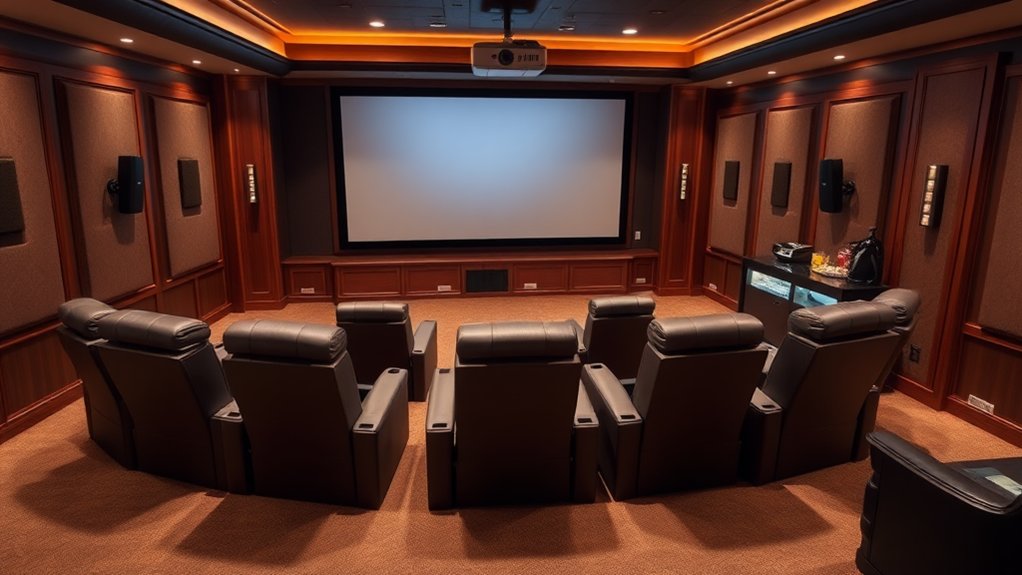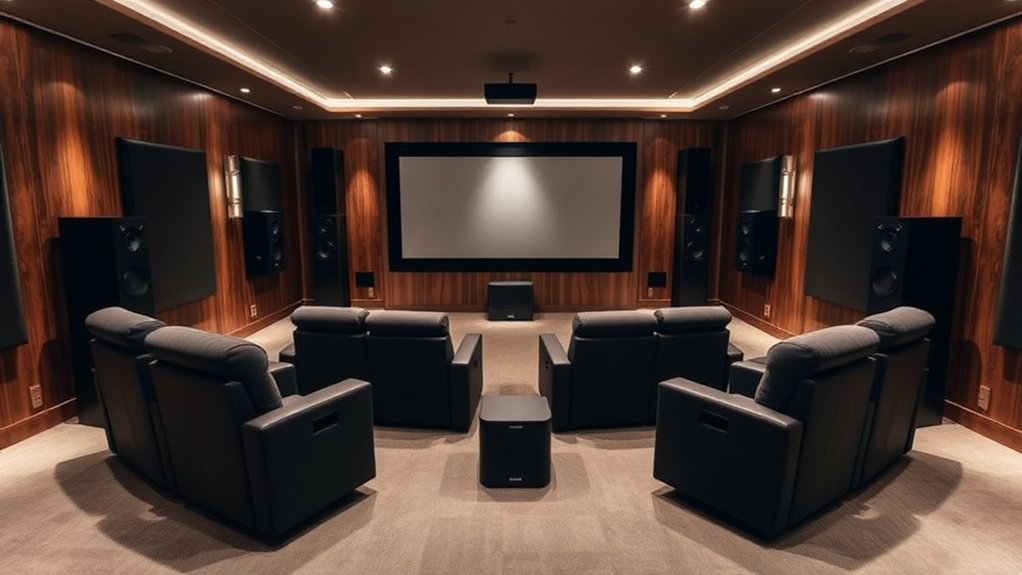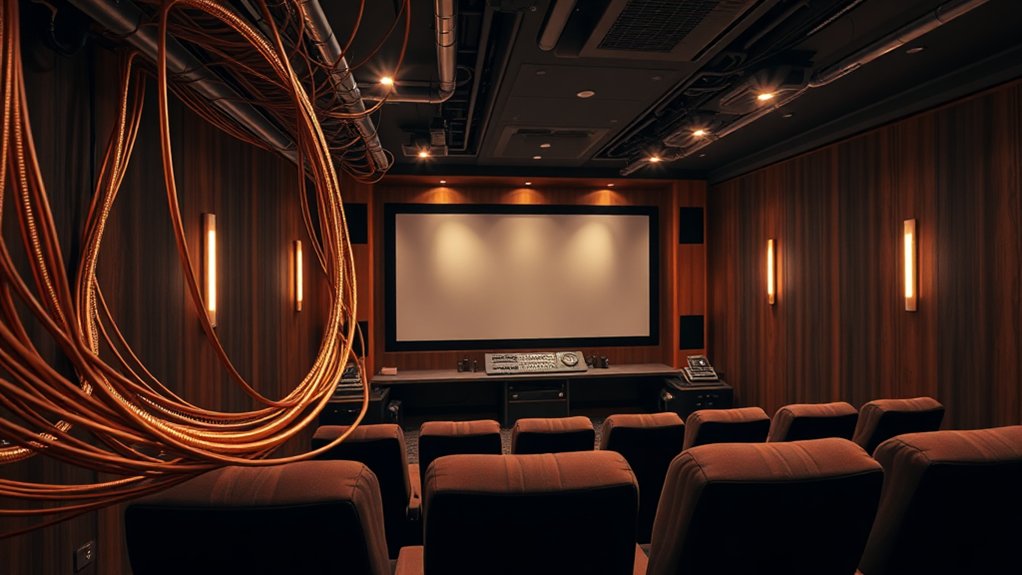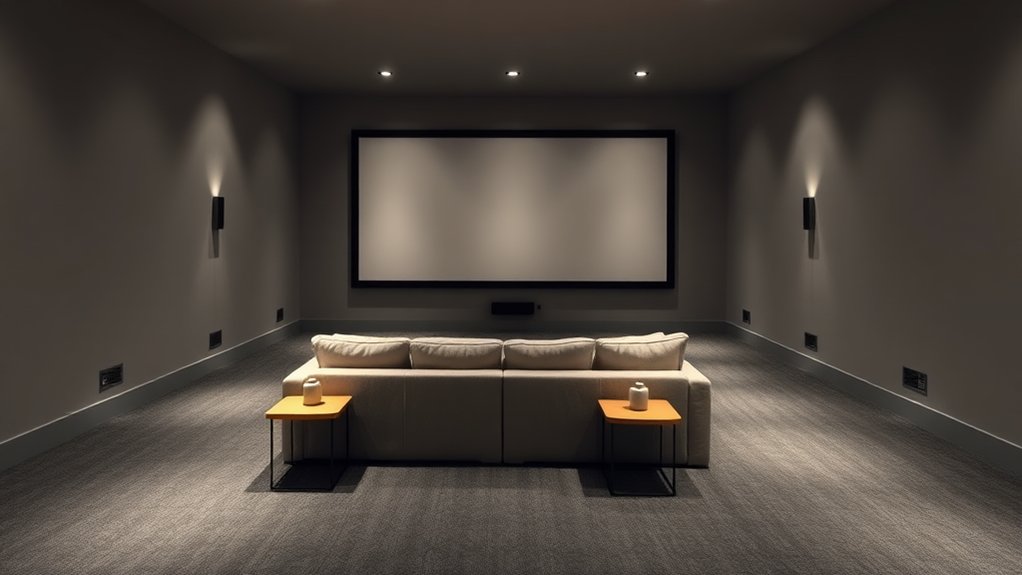When planning your home theater, start with the right dimensions—aim for a rectangular room around 24 feet long, 15 feet wide, and 9 feet high. For seating, keep comfort in mind; stagger seats and make sure you’ve got enough legroom. Screen size should match your viewing distance (think 10 inches per foot). Improve acoustics with panels, proper lighting, and cozy décor. Plus, don’t forget neat cable management. Who knew creating your dream space could be so easy? Stick around to investigate more tips!
Key Highlights
- Choose a rectangular room size of at least 24×15 feet with a 9-10 foot ceiling for optimal acoustics and viewing experience.
- Arrange seating to occupy 80% of the room’s width, with a minimum of 2 meters of legroom between rows for comfort.
- Follow the “Rule of 10” for screen size, placing the screen where the top aligns with the lower third and is centered.
- Implement a warm lighting scheme with adjustable dimmable fixtures to create an inviting atmosphere while avoiding screen glare.
- Ensure efficient cable management and accessible storage for AV components to maintain a clean look and prevent safety hazards.
Understanding Room Dimensions and Shapes
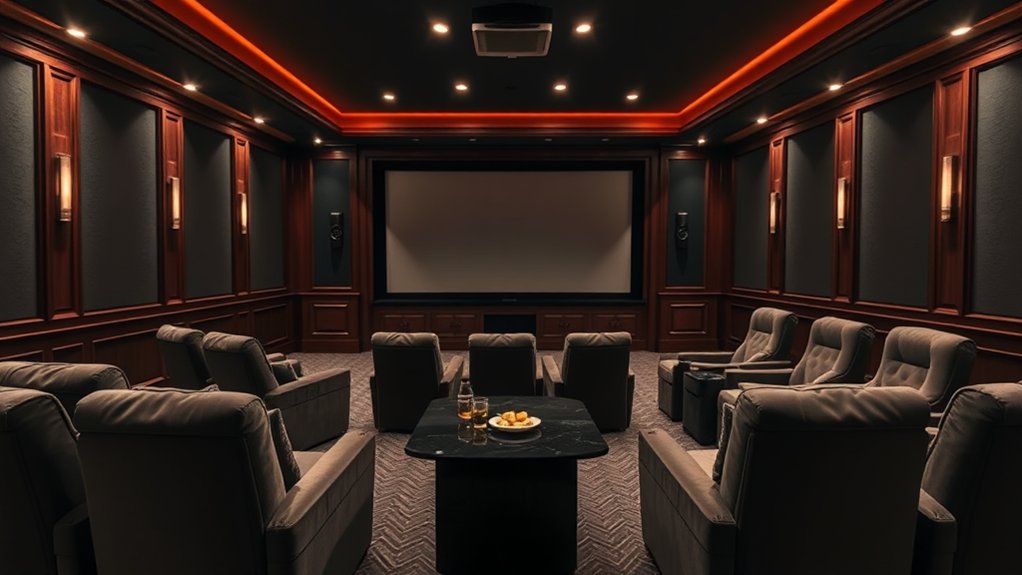
When you’re designing a home theater, understanding room dimensions and shapes is crucial, as the right layout sets the stage for an immersive viewing experience.
Aim for a room roughly 24 feet long by 15 feet wide, with a ceiling height around 9 feet; this creates an ideal environment for sound and visuals. Remember, rectangular rooms work best for predictable acoustics, whereas square spaces can lead to weird echoes that might make your blockbuster sound like a science fiction film gone wrong. Utilizing dimension ratios—like the golden ratio—can help mitigate sound issues. Additionally, a standard ceiling height of 9 to 10 feet ensures optimal acoustics. Overall, selecting a suitable shape and size keeps your viewing experience rich, so you won’t regret investing time in thoughtful planning.
Who wants a DVD of bad acoustics, right?
Optimizing Seating Layout for Comfort
After establishing your room dimensions and shapes, it’s time to turn your attention to how you arrange seating for ideal comfort.
Think about using about 80% of your room’s width for seating to prevent overcrowding. Maintain roughly 2 meters between rows, ensuring enough legroom and room to recline comfortably; nobody wants to feel like a sardine! To maximize your seating capacity, remember that total seating width should be calculated as 80% of the room’s horizontal width.
Stagger or curve your seating arrangement to improve sightlines and audio quality. If you’re fitting eight seats in a 5m by 6m room, prioritize a configuration that avoids obstructing views. To enhance the visual/audio quality for all viewers, ensure you consider optimal seating position.
Finally, choose seats with features like lumbar support or reclining abilities to keep everyone cozy during those extended movie marathons. After all, what’s a theater without comfort?
Selecting the Right Screen Size and Placement
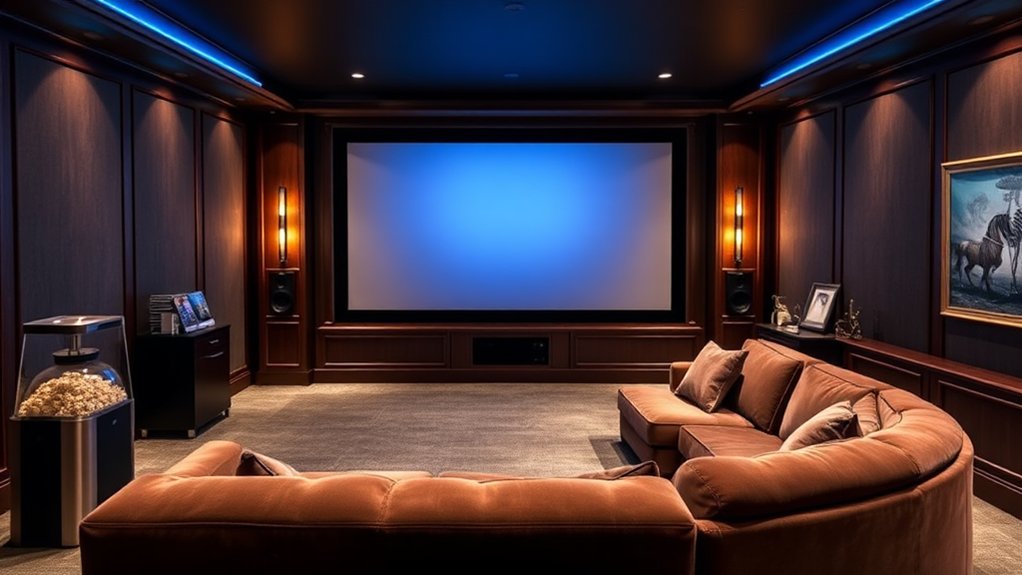
Choosing the right screen size and placement is crucial for crafting your home theater experience—after all, a visually stunning movie is just as important as a comfy seat!
To determine the ideal screen size, think about the viewing distance; the “Rule of 10” suggests 10 inches of screen size for every 1 foot of distance. For example, if you’re sitting 10 feet away, a 100-inch screen would work well. Additionally, remember that optimal screen size can be calculated by dividing your room depth by 2 for personalized enjoyment.
For optimal viewing, use the “Rule of 10”: 10 inches of screen size for every foot away you sit.
Next, consider placement—ensure the top of the lower third of the screen aligns with eye level for comfort. Centering the screen on the wall helps reduce distortions.
Don’t forget about ambient light and projection distance; both can drastically affect your viewing pleasure. After all, who wants a beautiful picture marred by glaring reflections?
Enhancing Acoustics With Treatment Solutions
Transforming the visual experience of your home theater is just the beginning; the sound quality demands equal attention to create a truly immersive environment.
Acoustic panels play a vital role in reducing those annoying sound reflections and echoes, making dialogue clearer and music more colorful. You’ll want to cover about 30-40% of your wall space with these sound-absorbing beauties, which can even come in colors that match your decor.
Don’t overlook bass traps, either; they tackle the low-frequency chaos often found in corners, ensuring that bass is punchy, not muddy.
Finally, consider diffusers, which help maintain a lively sound as they spread those sound waves evenly. After all, who wants a flat, boring audio experience, right?
Creating the Ideal Lighting Ambiance
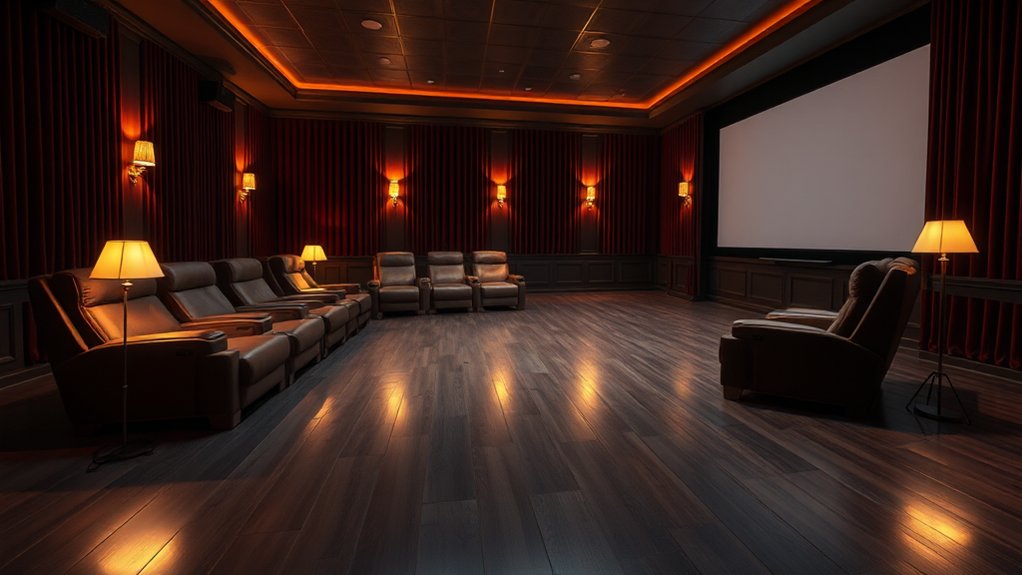
How can you create the perfect lighting ambiance in your home theater that complements your cinematic experience? Start by zoning your lighting. Designate areas—like the screen, seating, and rear—to control illumination separately with dimmable recessed LED lights, ideally 4-6 fixtures.
This way, you can brighten up for setup or dim for immersion. For added flair, install wall sconces for soft accent lighting and consider hidden LED strips for that subtle mood boost.
Don’t forget about the direction of your light: aim it upward or downward to prevent glare on the screen. Finally, choose warm white lights (about 2700K) for a cozy vibe and avoid harsh fluorescents—unless you want your theater to double as a dentist’s office!
Incorporating Architectural Features in Design
When you think about designing your home theater, it’s crucial to contemplate how existing architectural features can improve the overall experience. For instance, if you have alcoves or bay windows, consider using them for built-in seating or equipment niches—this keeps your space tidy and maximizes sightlines.
Exposed beams can elevate aesthetics; finish them with materials that complement your décor. When positioning your screen, always account for doorways or vents to maintain functionality.
Exposed beams enhance your space’s aesthetics; choose complementary finishes and keep doorways and vents in mind when placing your screen.
Utilizing existing wall recesses for speakers can lead to a more immersive sound experience. Finally, if you have varying ceiling heights, capitalize on those by installing indirect lighting or integrating acoustic treatments, ensuring your design isn’t just visually pleasing, but acoustically superior too.
After all, who doesn’t want their home theater to sound as good as it looks?
Effective Speaker Placement Strategies
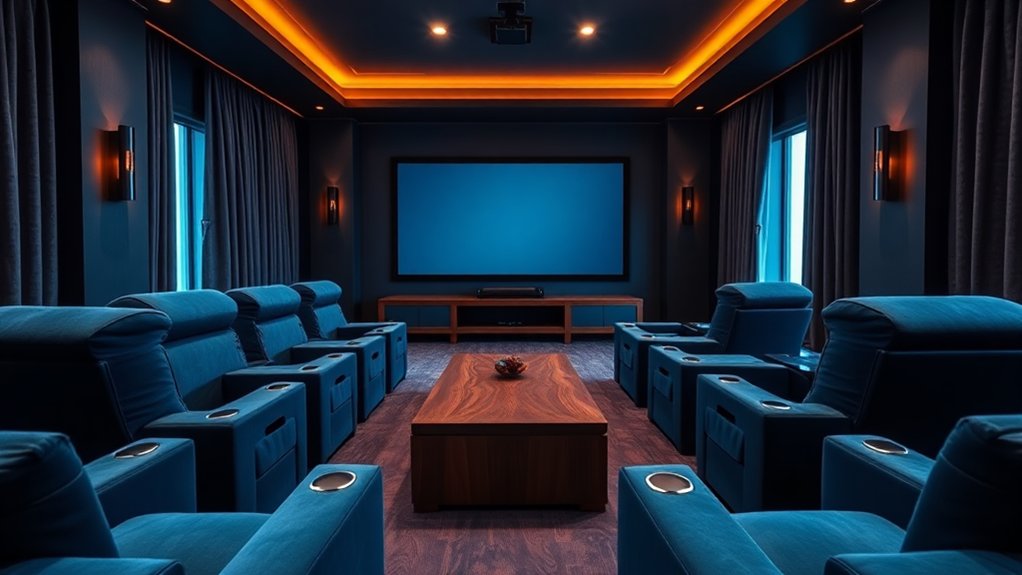
Architectural features play a key role in shaping your home theater experience, but no matter how stunning your design, the sonic success of your setup hinges on effective speaker placement.
Start by positioning your main left and right speakers about 25-30 degrees off-axis from your central listening spot to create accurate sound imaging. Make certain the tweeters are at ear level for ideal clarity.
Your center channel should align directly with the listening position, ideally at head height. For surrounds, place side speakers slightly behind you, with tweeters about two feet above ear level.
And if you’re feeling adventurous with subwoofers, try the “subwoofer crawl” method—who knew your listening location could double as a bass-hunting expedition? Additionally, consider incorporating a soundbar’s immersive audio capabilities to elevate your overall sound experience.
Configuring Aisle Space and Movement
Creating a comfortable and efficient home theater isn’t just about the screen and sound; it furthermore hinges on how well you configure aisle space and movement.
Ideally, you’re aiming for at least a 20-inch aisle width–a snug 14 inches is just asking for backaches during your epic movie marathons! Positioning aisles on both sides of seating not only boosts accessibility but also creates a smoother traffic flow, making it easier for viewers to navigate without causing a scene.
Don’t forget to calculate your seating using the formula: (Room Width) – (Aisle Width × Number of Aisles) ÷ Seat Width.
And let’s be real, who doesn’t appreciate ample legroom and easy access, especially when nature calls mid-epic saga?
Balancing Decor With Functionality
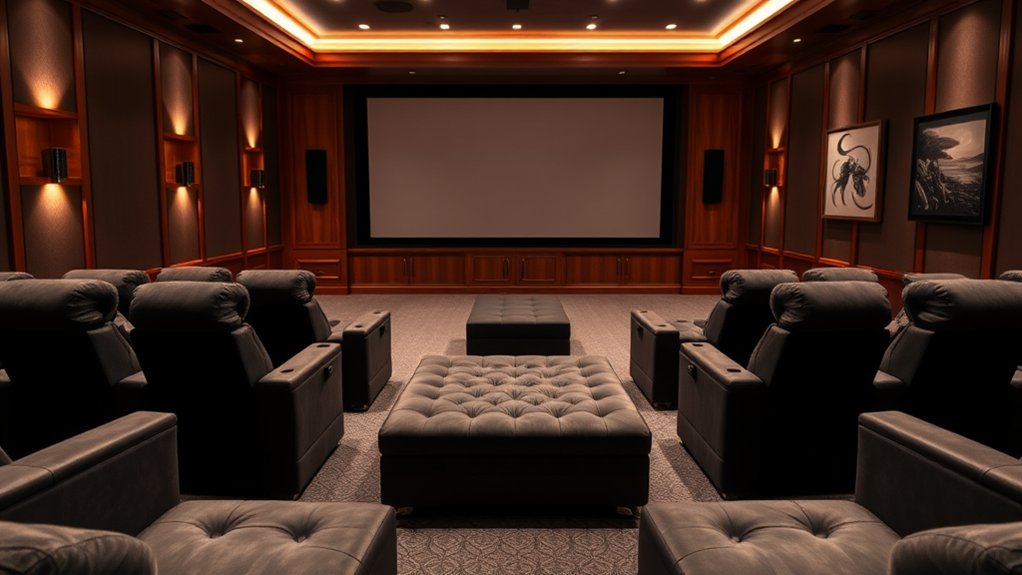
Though you might envision a home theater as merely a space for watching films, it’s vital to keep in mind that the decor should work hand in hand with function to create an inviting atmosphere.
Start by harmonizing design elements; for instance, match wall fabric textures with seating materials to improve visual cohesion. Lighting plays a significant role too—consider recessed fixtures and adjustable LED strips to create ambient lighting without causing screen glare.
Harmonizing design elements and thoughtful lighting enhances both visual cohesion and the overall ambiance of your home theater.
Then, select dark shades for your walls, which not only improves viewing clarity but also sets the mood.
Finally, don’t forget personalized themes that showcase your interests, as what’s a home theater without a little character?
Balancing these aspects guarantees you achieve both style and comfort.
Planning for Storage and Equipment Needs
As you continue shaping your home theater into a cozy cinematic haven, don’t overlook the importance of planning for storage and equipment needs. Start with dedicated audio racks, offering multiple compartments to accommodate your AV components—think gaming consoles and streaming devices.
The key is to measure your space carefully to guarantee everything fits without crowding. You wouldn’t want your Blu-rays to become reluctant participants in a game of Tetris, right?
Concealed cable management won’t only keep your space looking sleek but will also reduce safety hazards.
Furthermore, consider the airflow around your gear to avoid overheating—nobody wants a drama unfolding between your electronics! With a little planning, you’ll create a room that’s as functional as it’s enjoyable. Additionally, investing in quality speakers like those from the Polk Audio T50 series can dramatically improve your audio experience.
Frequently Asked Questions
How Can I Reduce Noise From Outside My Home Theater?
To reduce outside noise in your home theater, seal gaps, use sound-absorbing materials like acoustic panels and heavy curtains, and consider adding solid doors. Improve insulation and investigate soundproofing tools for better noise management.
What Are the Best Materials for Soundproofing a Home Theater?
For soundproofing your home theater, use fiberglass insulation, acoustic panels, and mass-loaded vinyl. Seal gaps with weatherstrips and caulk. Consider soundproof doors and windows for effective noise reduction, enhancing your overall viewing experience.
How Do I Choose a Theme for My Home Theater Decor?
To choose a theme for your home theater decor, think about your favorite movies or hobbies. Consider color preferences, design styles, and how you plan to use the space for a personalized atmosphere.
Can I Build a Home Theater in a Small Room?
Yes, you can build a home theater in a small room. Just choose compact furniture, wall-mount speakers, and optimize lighting. With the right design, you’ll enjoy an immersive cinematic experience without sacrificing comfort.
What Technology Enhances the Home Theater Experience?
To improve your home theater experience, invest in immersive sound technologies like Dolby Atmos or DTS:X, and pair them with high-quality visuals and acoustic treatments. This combo delivers a enthralling, lifelike audio-visual experience you won’t forget.

